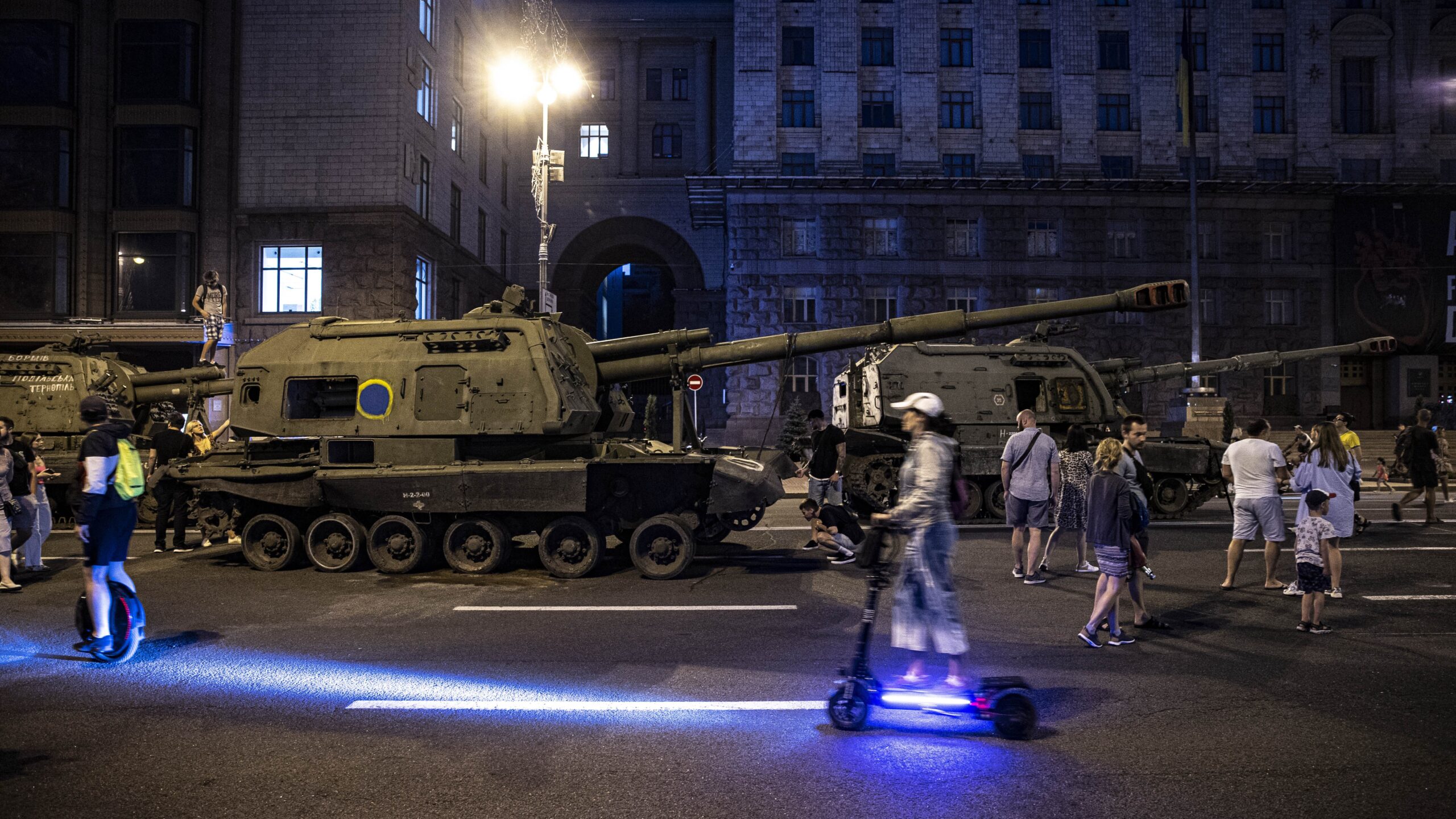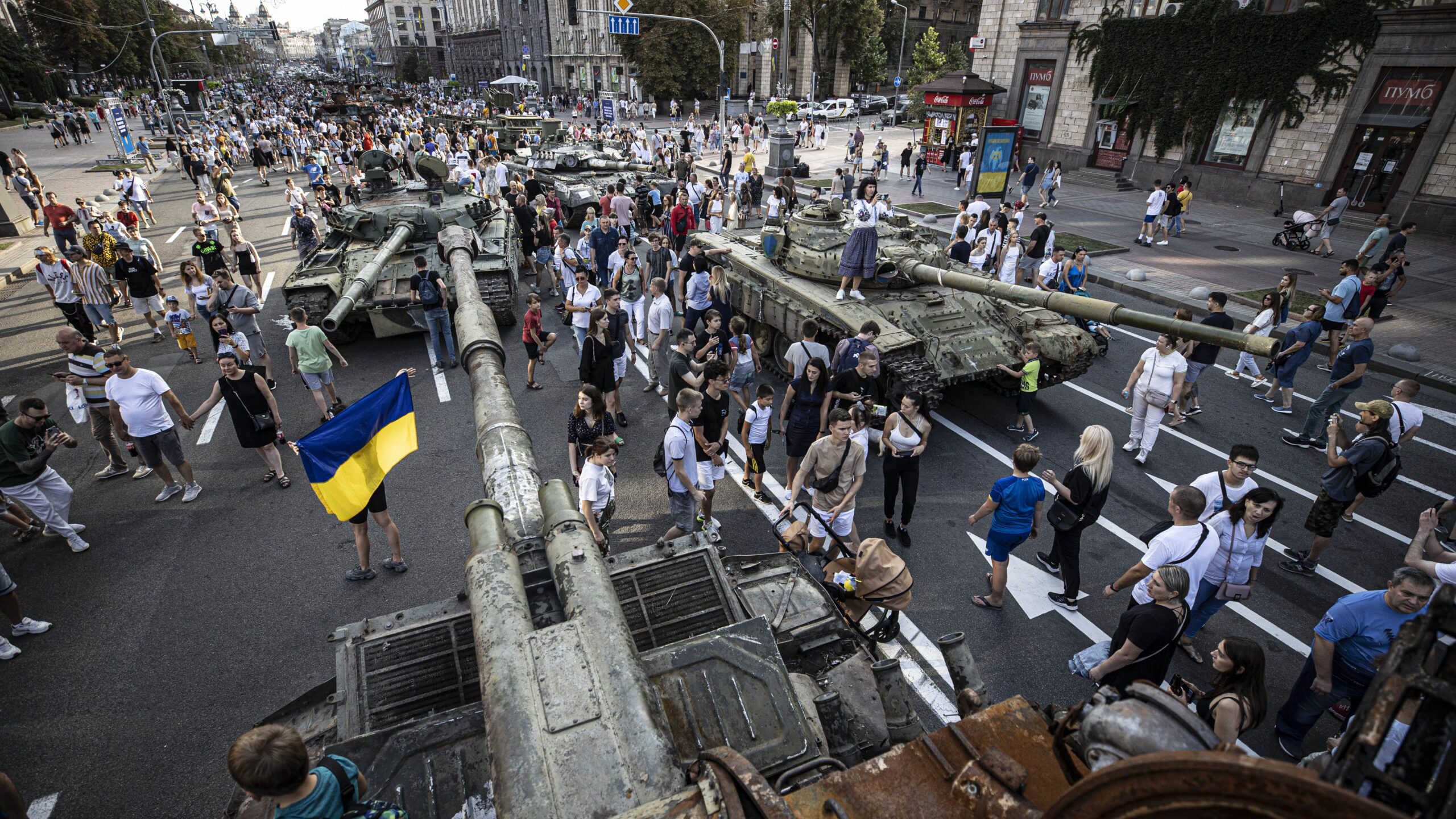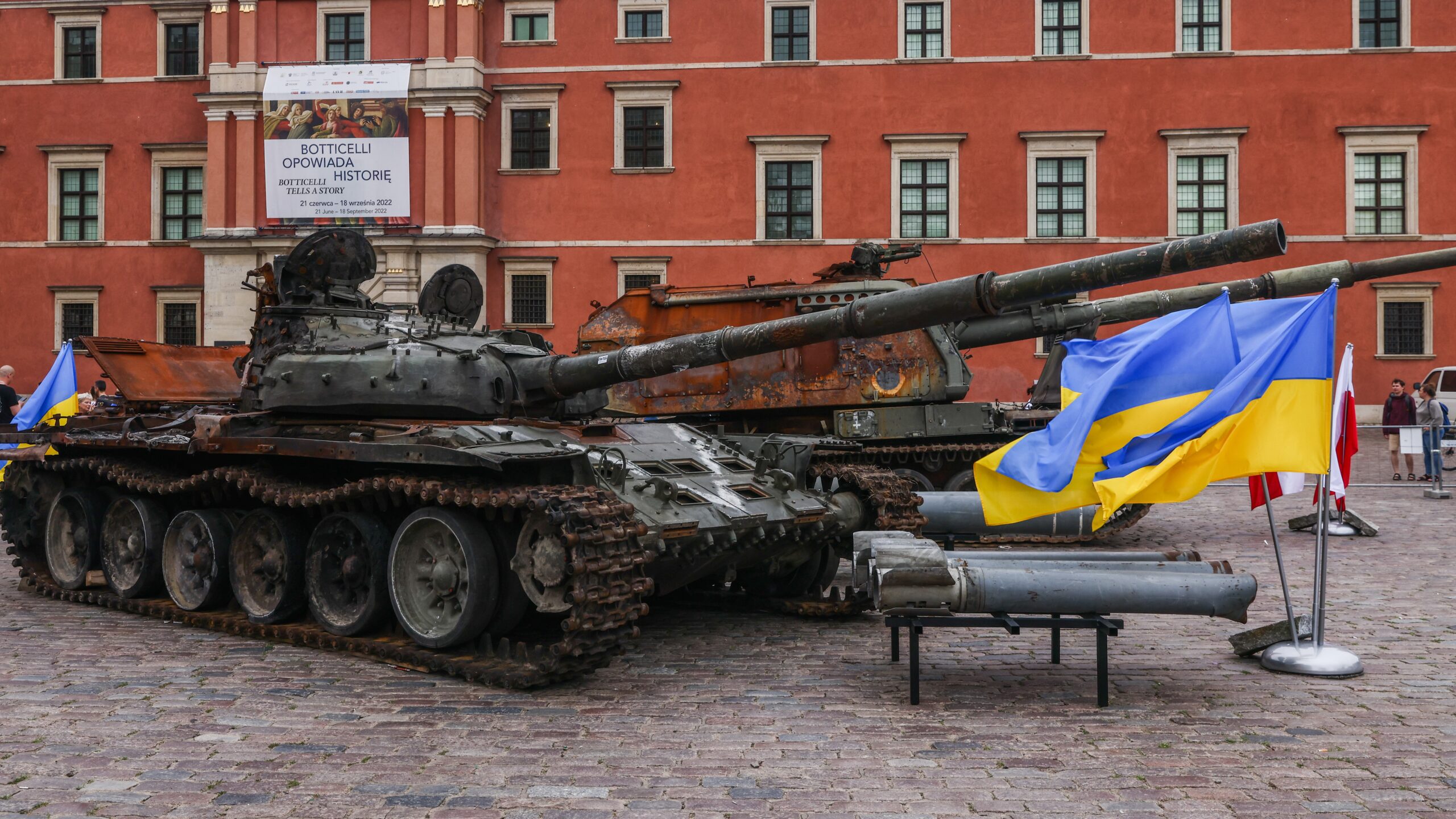REUBEN JOHNSON

WARSAW — The rapid success of Ukraine’s counteroffensive in recent days has left Russian forces retreating and yet more videos on social media of abandoned tanks and artillery units. And for Russia, every piece of hardware destroyed or abandoned on the battlefield underlines a growing consensus among Russia watchers that Moscow’s losses of both personnel and equipment in Ukraine are reaching a potential breaking point.
Analysts particularly point to industrial challenges facing Russia’s military in discussions with Breaking Defence and in public writings. Six months into what was expected to be a quick strike campaign, facing a Ukraine push that has reportedly liberated the key Russian logistics hub of Izium, Russia’s ability to resupply for its own counter is deeply in question.
Pavel Luzin, a Russian defense sector analyst from the Foreign Policy Research Institute (FPRI), has compared Moscow’s declining production in the defense industrial sector and sinking manpower levels with the rate of consumption of munitions and personnel losses in the war in Ukraine. He came to the inescapable conclusion that the Russian war machine will soon be unable to function due to a lack of both.
“For Russia, six months of war have led not only to colossal irreplaceable losses in manpower, but also to a huge waste of weapons and military equipment: guided missiles are already very scarce, shells for artillery and armored vehicles will be exhausted by the end of the year, and the state of military aviation precludes a full-scale air campaign,” Luzin wrote in an Aug. 30 analysis. “Because of the sanctions, Russia cannot continue full industrial production of weapons and replenish its arms stockpiles, which are rapidly running out.”
There are plenty of anecdotes to back up the idea that Russia is having a hard time keeping its forces supplied. One recent video shows two Ukrainian soldiers inspecting a Russian T-80BVM model tank produced at the Omsk plant. They reveal that none of the reactive armor compartments were loaded with the explosive charges that are supposed to detonate and destroy an incoming ATGM before it can penetrate the hull.
“Look at this, they are all like this,” one of the two Ukrainians says as he opens the reactive armor blocks one after the other and finding them filled with rubber quadrangles roughly the size and thickness of the average mousepad. “These would not protect against anything.” The other Ukrainian soldier then comments that the turret is not a standard T-80 design but an older model of T-64 and that the commander’s machine gun model on the turret lacks the required range.
Other photos taken earlier in the year show upgraded T-72B3 and T-80 models fitted with “skirt armor,” which are soft-sided pouches attached to the chassis, filled with sand and composite “egg-carton” shape forms designed to add rigidity to the individual protective pouches. A few years ago Russian state agencies were reporting that there were some 1,000 tanks equipped with this kind of external protective, ignoring the fact that simple sand and composite inserts are obsolete protection against current-day ATGMs.
Asked about the takeaway from those photos and videos, a former US Army special forces operative now serving in one of the international legions in southern Ukraine confirmed such equipment has become fairly common on the battlefield
Two powerhouse defense companies have joined forces to deliver the world's finest fighting force's most advanced military truck prototype.
“Yeah, we have seen the same kind of unprotected tanks,” he told Breaking Defense. “The [reactive armor] compartments are sometimes filled with nothing but cardboard. It is obvious how pervasive the corruption has been. Everyone — including up to the generals — has been stealing everything in sight.”
Asked how long Russian combat operations could be sustained in light of the dismal state of the units in the field he had been he answered confidently: “This will be over by the Spring. Maybe even by the end of the year.”
Artillery Concerns
Going through open-source reporting, public analyses from researchers, discussions with sources and what little reliable information still comes out from Russia, it is clear there are major challenges ahead for Russia when it comes to a key part of its military strategy: conventional artillery.
In the six months since the Feb. 24 invasion, Moscow’s military has expended, per best estimates, no less than seven million shells. Add to this consumption the number of artillery rounds lost due to Ukrainian strikes on Russian ammunition stockpiles located close to the front lines. If the conflict continues at the pace seen thus far, Russia’s military will find itself running short of shells by the end of the year and will have to conserve their use.
Another issue is that artillery and tank gun barrels wear out after a finite number of rounds have been fired. Russian troops are not known for being diligent about the maintenance of these systems, so the most likely outcome is that the shortage of artillery rounds will be accompanied by a drop-off in the number of useable artillery pieces as well. A sign that the shortage of useable tubes has already begun may be Moscow’s recent increased use of Almaz-Antei S-300 and S-400 missiles in their secondary surface-to-surface ballistic missile mode rather than as air defense weapons.

Ukrainians arrive at Khreschatyk Street to see the seized military equipment and weapons including tank and motorized artillery systems belonging to the Russian army displayed by Ukraine ahead of the country’s 31st anniversary of Independence Day in Kyiv, Ukraine on August 21, 2022. (Metin Aktas/Anadolu Agency via Getty Images)
Another indicator of Russia’s concern about supplies? Russia has reportedly turned to North Korea to purchase millions of artillery rounds, chiefly 152mm shells, and other munitions from the isolated Stalinist dictatorship. While North Korea has a long-standing emphasis on conventional artillery, that Russia’s vaunted military would have to turn to Pyongyang for military aid speaks volumes.
“The only reason the Kremlin should have to buy artillery shells or rockets from North Korea or anyone is because [Russian President Vladimir] Putin has been unwilling or unable to mobilize the Russian economy for war at even the most basic level,” Frederick W. Kagan from the American Enterprise Institute told the New York Times. “This is very likely an indication of a massive failure of the Russian military industrial complex that likely has deep roots and very serious implications for the Russian armed forces.”
Meanwhile, there are scant indications that Russia’s defense industrial sector can keep pace with the marked spike in demand the op-tempo of the war in Ukraine is creating.
One of the most important suppliers at the bottom of the munitions food chain is the Kazan Gunpowder Plant, which in 2014 purchased manufacturing equipment from Germany, Switzerland, and Austria. This required the plant to acquire chemical components for its production from foreign suppliers as well, the purchase of which is now denied due to sanctions. Similar acquisitions of foreign-design machinery were made by the Federal Research and Production Center (FNPTs) Altai and the other Russian developers and suppliers of gunpowder and solid rocket propellants.
Several Russian analysts assessed that the ties with these foreign suppliers deteriorated in 2014 after Moscow’s invasion of Crimea. The production equipment acquired also began to wear and tear before being properly serviced or modernized. The plants also began to lose personnel due to the “peaks and valleys” nature of defense procurement and production costs began to increase. A subsequent corralling of several of these munitions enterprises under one management structure enhanced neither quality levels nor productivity. Labor efficiency levels sank to levels 9-10 times lower than that of American counterparts to these firms, according to one estimate.
In the last week of August these gunpowder plants saw a sudden, unscheduled visit by the Deputy Prime Minister in charge of the defense sector, Denis Manturov, and Deputy Chairman of Russia’s National Security Council, Dmitri Medvedev, who was formerly Russian president from 2008-2012 and Prime Minister from 2012 to 2020.
“Inspections by officials at this level are tell-tale signs that there are serious deficiencies in the production levels,” said a Russian defense specialist in Moscow who spoke with Breaking Defense. “There is also very little chance that these senior officials — no matter how forcefully they lean on the management teams at these enterprises — are going to inspire the workforce to magically become more capable and efficient.”
Imported Parts Becoming A Challenge
Beyond these manufacturing shortcomings are the multiple failures of Russian defense firms to reduce their dependence on imported components. Citing the work of several foreign analytical reports, Luzin points out that Russia’s industry has become progressively more dependent on foreign-made electronic systems, due in no small part to the fact that import substitution it is flawed concept.
“The very notion of import substitution and autarchy is a dead-end, unreasonable, and generally false idea that simply rejects the division of labor and the benefits of international cooperation,” he writes. “For an authoritarian system and the command-administrative economic model, the path to self-isolation and inevitable self-destruction is predetermined.”
This has proven to be the case with the most sophisticated systems in Moscow’s arsenal. According to a Ukrainian missile guidance system designer who spoke to Breaking Defense at the beginning of the war, who is very familiar with its design, some 70 percent of the components used in the now-famous Kalibr cruise missile (9M729) are of foreign origin. “There is now virtually no way for Russia to re-start a production line at this point,” was his assessment in early March.
Moreover, even prior to Moscow’s invasion and the subsequent sanctions regime imposed by the US, the EU and others, the production of this missile and other munitions with a range in excess of 300 km was no more than 225 per year, per sources. Russia has tried to compensate for the small numbers of modern systems available by bombarding Ukrainian cities with the nearly obsolete Raduga Kh-22 cruise missile — a 1960s-era design. These are typically launched from Tupolev Tu-22M bombers while they are still safely cruising in Belarusian air space.
However, these long-range missiles are no longer being manufactured and the Kh-32 that was developed to replace it began series production only four years ago at a rate of about 20 per year. There are today no options for a dramatic increase in missile output, causing the use of long-range missile systems to drop from the dozens per day that were fired in the beginning of March to a parsimonious launch rate of only one missile every few days.

Russian T-72B tank and 2S19 Msta self-propelled howitzer destroyed on the battlefields of Ukraine are seen as part of a display ‘For Our Freedom and Yours’ at Royal Castle Square. Warsaw, Poland on July 2nd. 2022. The exhibition showing damaged military hardware is intented to prove that Russia can be defeated. Later it will travel to other European capitals. (Beata Zawrzel/NurPhoto via Getty Images)
Armor And Air
The same culprits bedeviling Russian munition production are factors in any attempt to replace tanks or aircraft lost in the fight. And if you look at the almost daily videos that pop up online, it is clear the losses are real.
When the war began, only 2,000 of the roughly 3,300 tanks in Russian army service were rated as modern or upgraded. Although numbers vary, even conservative estimates put the loss of Russian tanks to date at more than 1,000 units. Ukrainian reports are that at least 34 percent of the tanks lost by Russia are due to them being abandoned by their crews, a significantly higher rate than the norm for combat operations.
Aviation losses have been lower than in the armored vehicle community, but production of new combat aircraft has all but halted. The support of existing platforms in operation is also severely impacted by the same sanctions against the importation of foreign electronics that cripples Russian missile production.
One source with knowledge of Russia’s industrial status told Breaking Defense that production of the Sukhoi Su-35 had declined precipitously from a planned 120 aircraft in 2021 to an actual number of 10-12 units. At this point, what remains of the aircraft industry is only capable of manufacturing a small number of essentially hand-assembled aircraft with whatever production materials remain on-site and with a complete loss of any economies of scale.
Combat losses to Ukraine’s own tactical airpower and air defense units has the Russian Aerospace Forces (VKS) unable of establishing air superiority in the conflict. Pilots stay within safe corridors or “bubbles” provided by their SAM units close to their lines and do not place themselves in harm’s way.
The lack of confidence in their survivability is demonstrated in the difference between their operational profile in the Ukraine theatre and how they perform in the Vostok 2022 joint training exercises currently taking place in the Russian Far East. In Ukraine, VKS Sukhoi Su-25s tend to fly at very low altitude and fire unguided rockets to reduce the probability of being engaged by the Ukrainian Air Forces. Meanwhile, in the Vostok exercises, the same model Su-25s drop unguided bombs from medium altitudes as per standard procedure — as their targets are only mockups representing “SAM systems of the conditional adversary” that do not shoot back.
Desperate Measures
In April, the Royal United Services Institute (RUSI) in London published an assessment that included details of how Russia intends to try and evade the sanctions regime imposed on them by the West. Moscow’s basic strategy is to re-invigorate the channels for illegal procurement of foreign technology that were utilized by the Soviet Union during the Cold War.
The difference between today and the Cold War period is that there is no nation more familiar with the tricks used by Russia to circumvent this technology export bans than Ukraine itself, which is determined to see Moscow thwarted. Its intelligence services have been able to procure detailed knowledge of Russian operations, to include Russian defense industry’s high-tech “shopping list” of high-technology components, copies of which have been provided to the US publication Politico.
Nations that maintain ties with Russia at one level or another — the Czech Republic, Serbia, Armenia, Kazakhstan, Turkey, India, and the UAE — have also been mentioned as potential third-party pass-throughs that could place large orders for these electronic systems and then illegally transship them to Russia.
China has additionally been identified as another portal that could be used for Moscow as a mechanism for financing these purchases. Zongyuan Liu, a fellow at the Council on Foreign Relations in New York, has stated that “Russia could take advantage of Chinese ‘burner banks’,” a reference to the “burner phones” used by drug traffickers and other criminal operatives, “which facilitate illegal transactions but are then liquidated or reconstituted before their activities are discovered.”
“This is an established model,” she recently wrote in the Financial Times, “and it is already used by North Korea (DPRK) and the Iranians.” If the Russians begin to operate this way on a large scale it will have to involve Beijing — creating a situation where “China could have more leverage over Russia in negotiating oil and gas deals, meaning it could buy Russian oil and gas at heavy discounts.”
And of course, both North Korea and Iran could lend their support and expertise to Russia on the best way to get around sanctions. Increased military ties to Russia — North Korea through artillery sales, Iran through drone sales — likely comes with greater political discussions as well.
Six months in, the fight in Ukraine is far from finished. But for those in Kyiv and its supporters, even before the success of the last few days, there are signs the Russian military machine could run out of steam, limiting Putin’s options to push back and reclaim territory.
No comments:
Post a Comment